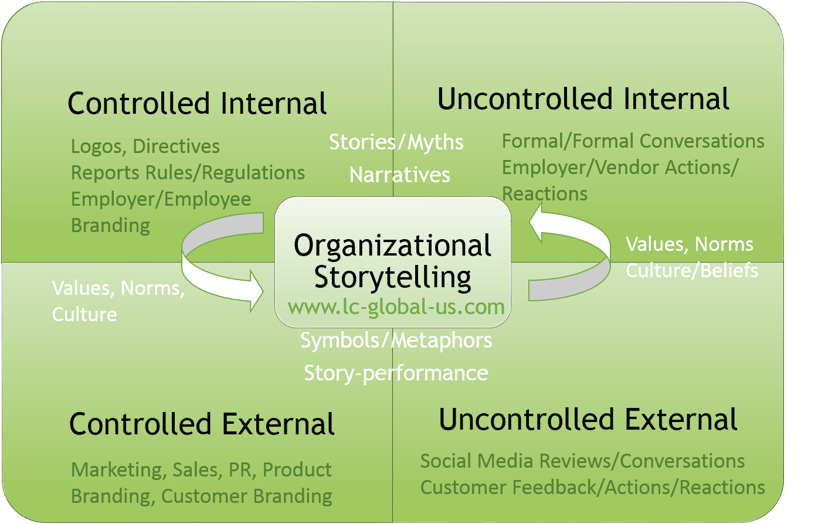Organizational storytelling is a new buzzword in the world of organization development. While for decades, nothing but quantitative data and process orientation mattered, we are now finally paying more attention to less tangible factors such as organizational culture and storytelling.
As with many new trends though, what is meant by the term storytelling is not currently well defined. It is often used interchangeably with branding, marketing, visionary leadership and indicators of organizational culture. Recommendations range from suggesting that leaders learn the art of storytelling to making sure that every story gets heard in the organization.
Storytelling Fields
If we look at corporate storytelling more closely, we can distinguish various forms of narratives in organizations which reside in four different fields:
- The controlled internal realm
- The uncontrolled internal realm
- The controlled external realm
- The uncontrolled external realm
All four realms function as platforms for stories, myths, beliefs, metaphors, symbols and story performance. In all four realms, the storytelling activities are nourished by the values, norms and culture of the organization and its surrounding systemic fields.

The difference between the four realms is based on how much control the organization has over them. That is why the uncontrolled internal stories, which most of the literature currently addresses, always compete with the controlled stories represented in active employer/employee branding. At the same time, external controlled stories told through marketing, PR and sales activities compete with the uncontrolled external reactions and actions of the market and customers. It is in the midst of the dynamics between these four quadrants that an interesting storytelling dance unfolds.
Utilizing Organizational Storytelling
To utilize the power of stories effectively, we need to realize that regardless of all the attention that organizational storytelling deserves, companies actually do not provide the platform for vibrant storytelling. To the contrary, often, they are a place where uncontrolled storytelling is discouraged.
To be effective in our analysis or with active storytelling initiatives, we must first determine which realm we are actually trying to influence. The controllable internal realm requires a consistent story that values the success factors and strengths of the organization as much as the values and existing organizational culture. For the brand story to fall on fruitful ground, all factors need to be aligned – from organization design, HR processes, employee engagement, to marketing and vendor relationships.
The uncontrollable internal narratives can serve as an effective measure of organizational climate, culture and values. Again, although we are talking about the uncontrolled side of the storytelling organization, stories in this realm compete with the more engineered statements of the company. Therefore, the question in this realm is which stories are not told? Which stories circle underground as common knowledge that nobody actually talks about? Which stories are told, but not listened to? Which story performances are at play? Who is involved and why?
Exactly the same questions can be asked for the external side, which – due to its outreach – is even more difficult to fully understand than the internal uncontrollable side.
Consistent Storytelling
Many more distinctions could and should be made by differentiating between the origin; the directedness; the level of fragmentation of the stories, symbols, myths and narratives; and many others.
Looking at storytelling from a slightly more differentiating angle, it becomes clear that telling a consistent organizational brand-story that effortlessly infiltrates the uncontrollable external and internal side is extraordinarily difficult.
That said, since human beings pay more attention to stories than to dry factual statements, an inconsistent story can do more harm than you might imagine. As much as we try to control stories and branding initiatives in the controllable realms, we can never maintain full control, and bad stories often travel much faster across the four quadrants than good ones.
---
About the author:
Erika Jacobi is the President of LC GLOBAL Consulting Inc., a boutique change and innovation consulting firm with offices in New York City and Munich, Germany. LC GLOBAL® leads organizations through important change and innovation processes to pave the way for unique transformation and sustainable growth. For more information visit www.lc-global-us.com or follow us on Youtube at http://bit.ly/1CPbMQ5.






